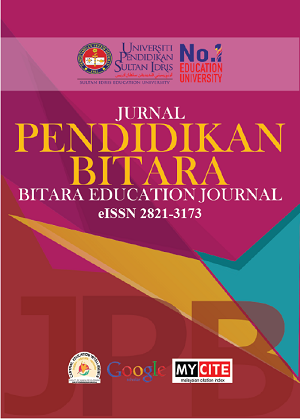Benefits and Challenges of Integration of Information and Communication Technology in the Teaching and Learning of Mathematics: A Systematic Literature Highlights
Manfaat dan Cabaran Pengintegrasian Teknologi Maklumat dan Komunikasi dalam Pengajaran dan Pembelajaran Matematik : Sorotan Literatur Bersistematik
DOI:
https://doi.org/10.37134/bitara.vol15.1.5.2022Keywords:
benefit, challenges, ICT, mathematics, integrationAbstract
Teaching and Learning (TnL) using technology today is an increasingly popular approach among students and teachers. The integration of Information and Communication Technology (ICT) in TnL for Mathematics subjects provides advantages and challenges to students and teachers. The purpose of this systematic literature review is to identify the benefits and challenges faced by students and teachers in implementing TnL Mathematics online. A survey of the articles was made between the publication year 2017-2021 using three databases namely ERIC, Google Scholar and Research Gate. The findings show that the integration of ICT in TnL Mathematics provides many advantages to students such as TnL process becomes more interesting, fun, improve conceptual understanding, form critical and creative thinking in problem solving, maintain focus, give students the opportunity to explore and learn independently and also improving student achievement. The challenges in integrating ICT in mathematics are the lack of technological facilities, limited internet access, limited knowledge and skills of teachers and students and also the lack of online TnL materials. Infrastructure facilities and internet access need to be improved to ensure that online learning can be optimally utilized by teachers and students. Various programs and workshops need to be designed and implemented to increase the knowledge, skills and confidence of teachers and students in applying online learning.
Downloads
References
Darchinie Rani Ravendra & Md Yusoff Daud (2019). Faktor –Faktor Yang Mempengaruhi Guru Matematik Sekolah Rendah Dalam Mengintegrasikan Penggunaan Teknologi Dalam Pdpc. Jurnal Dunia Pendidikan 1(3), 24-33.
Er, X. H. & Roslinda Rosli (2021). Kebimbangan dan efikasi terhadap pembelajaran Matematik dalam kalangan pelajar Tingkatan Empat. Malaysia Journal of Sciences and Humanities 6(3), 41-53.
Fatkhul Arifin & Tatang Herman (2017). The Influence of E-Learning Model Web Enhanced Course to Conceptual Understanding and Self-Regulated Learning in Mathematics for Elementary School Students. TARBIYA: Journal of Education in Muslim Society, 4(1), 45-52.
Iskrenovic-Momcilovic, O. (2020). Improving Geometry Teaching with Scratch. International Electronic Journal of Mathematics Education, 15(2), em0582.
Juwairiah Mustapah & Roslinda Rosli (2021). Tahap Kepuasan Pembelajaran Matematik Dalam talian Semasa Pandemik COVID-19. Malaysian Journal of Social Sciences and Humanities (MJSSH) 6(4), 1 – 20.
Kaushik Das (2019). Role of ICT for Better Mathematics Teaching. Shanlax International Journal of Education 7(4), 19-28.
Ketut Darma, Gede Made Karma & Made Anom Santiana (2020). Blended learning, inovasi strategi pembelajaran Matematika di era revolusi 4.0 bagi Pendidikan tinggi. Prosiding Seminar Nasional Matematika 3 527 - 539.
Lau, J. S. C. & Roslinda Rosli (2020). Pengetahuan Teknologi Maklumat dan Komunikasi Guru Matematik Sekolah Rendah. Malaysian Journal of Social Sciences and Humanities (MJSSH) 5(11), 71 – 84.
Moher, D., Liberati, A., Tetzlaff, J., & Altman, D. G. (2009). Preferred Reporting Items for Systematic Reviews and Meta-Analyses: The PRISMA Statement. Journal of Clinical Epidemiology, 62, 1006-1012. https://doi.org/10.1016/j.jclinepi.2009.06.005
Mailizar M., Almanthari, A., Maulina, S., & Bruce, S. (2020). Secondary School Mathematics Teachers’ Views on E-learning Implementation Barriers during the COVID-19 Pandemic: The Case of Indonesia. Eurasia Journal of Mathematics, Science and Technology Education, 16(7), em1860.
Mulenga, E. M., & Marbán, J. M. (2020). Is COVID-19 the gateway for digital learning in mathematics education? Contemporary Educational Technology, 12(2), ep269.
Nilson Valencia-Vallejo, N., López-Vargas, O., & Sanabria-Rodríguez, L. (2018). Effect of Motivational Scaffolding on E-Learning Environments: Self-Efficacy, Learning Achievement, and Cognitive Style. Journal of Educators Online, 15(1), n1.
Norfaizah Md Kamary & Mahizer Hamzah (2019). Kesediaan guru matematik daerah Kuala Langat dalam melaksanakan pembelajaran abad ke 21. Seminar Antarabangsa Isu-isu Pendidikan (ISPEN) 13, 110 – 130.
Nur Fatin Shamimi Che Ibrahim, Nur Farahkhanna Mohd Rusli, Mohd Ra’in Shaari & Kesavan Nallaluthan (2021) Persepsi Pelajar terhadap Aplikasi Multimedia Interaktif dalam Proses Pengajaran dan Pembelajaran Abad ke-21. Journal for TVET Practitioners 6(1), 15-24.
Nur Hafizah Razali & Fariza Khalid (2021). Penggunaan Aplikasi Pembelajaran Mudah Alih dalam Pembelajaran Matematik bagi Pelajar Sekolah Menengah. Malaysian Journal of Social Sciences and Humanities (MJSSH) 6(6), 73 – 85.
Nurul Shida, Sharifah, Hanifah, Norulhuda & Abdul Halim (2019). The Influence of ELearning towards Metacognitive Enhancement in Mathematical Problem Solving. International Journal of Emerging Technologies in Learning (iJET), 14(20), 165-173.
Panteli, P., & Panaoura, A. (2020). The Effectiveness of Using Mobile Learning Methods in Geometry for Students with Different Initial Mathematical Performance. Social Education Research, 1-10.
Phang, V,. I. & Nurfaradilla Mohd Nasri (2020). Tahap Kesediaan Dan Sokongan Bagi Pelaksanaan Pendekatan Penggunaan Teknologi Maklumat Dan Komunikasi Dalam Pengajaran Dan Pembelajaran Guru Sekolah Rendah. International Journal of Education and Pedagogy (IJEAP) 2(4), 489 – 508.
Valtonen, T., Leppänen, U., Hyypiä, M., Sointu, E., Smits, A., & Tondeur, J. (2020). Fresh perspectives on TPACK: pre-service teachers’ own appraisal of their challenging and confident TPACK areas. Education and Information Technologies, 25(4), 2823–2842.
Yaniawati, P., Kariadinata, R., Sari, N. M., Pramiarsih, E. E., & Mariani, M. (2020). Integration of e-Learning for Mathematics on Resource-Based Learning: Increasing Mathematical Creative Thinking and Self-Confidence. International Journal of Emerging Technologies in Learning (iJET), 15(06), 60-78.
Yang, X., Zhang, M., Kong, L., Wang, Q., & Hong, J. C. (2020). The Effects of Scientific Self-efficacy and Cognitive Anxiety on Science Engagement with the “Question-Observation-Doing-Explanation” Model during School Disruption in COVID-19 Pandemic. Journal of Science Education and Technology, 380-393.





